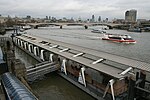Victoria Embankment
Buildings and structures on the River ThamesEngvarB from June 2015Parks and open spaces in the City of WestminsterStreets in the City of LondonStreets in the City of Westminster ... and 2 more
Victoria EmbankmentWaterfronts

Victoria Embankment is part of the Thames Embankment, a road and river-walk along the north bank of the River Thames in London. It runs from the Palace of Westminster to Blackfriars Bridge in the City of London, and acts as a major thoroughfare for road traffic between the City of Westminster and the City of London It is noted for several memorials, such as the Battle of Britain Monument, permanently berthed retired vessels, such as HMS President, and public gardens, including Victoria Embankment Gardens.
Excerpt from the Wikipedia article Victoria Embankment (License: CC BY-SA 3.0, Authors, Images).Victoria Embankment
Victoria Embankment, London Covent Garden
Geographical coordinates (GPS) Address Nearby Places Show on map
Geographical coordinates (GPS)
| Latitude | Longitude |
|---|---|
| N 51.507222222222 ° | E -0.12166666666667 ° |
Address
Embankment Pier
Victoria Embankment
WC2N 6NU London, Covent Garden
England, United Kingdom
Open on Google Maps










